22 Galapagos Sea Lion Facts: Diet, Habits, Photos & Videos
The Galapagos sea lion has often been called the “welcoming committee” of the Galapagos Islands. Please read on for the top 22 most interesting facts about the Galapagos sea lion! You’ll learn about their endangered status, diet, range, population, sounds and more.
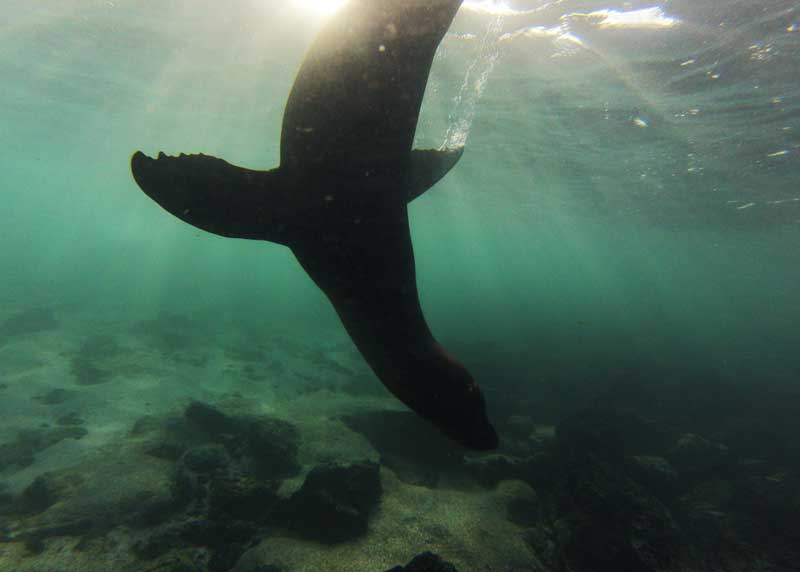
Galapagos Sea Lion Overview
- Latin name: Zalophus wollebaeki
- Location: The Galapagos Islands, and the Isla de la Plata in Ecuador
- Habitat: Near the coast or on the beach
- Population Status: Endangered, with 20,000-50,000 individuals
- Length: 5-8 feet in length (1.5-2.5 meters)
- Weight: Between 110 to 550 pounds (50 to 250 kilograms)
- Diet: Mostly sardines, sometimes lantern fish
- Physical features: Whiskers, flippers, and external ears
- Lifespan: 15-24 years
1. What is the scientific classification of a Galapagos sea lion?
- Kingdom: Animalia
- Phylum: Chordata
- Class: Mammalia
- Order: Carnivora
- Clade: Pinnipedia
- Family: Otariidae
- Genus: Zalophus
- Species: Z. wollebaeki
- Binomial Name: Zalophus wollebaeki
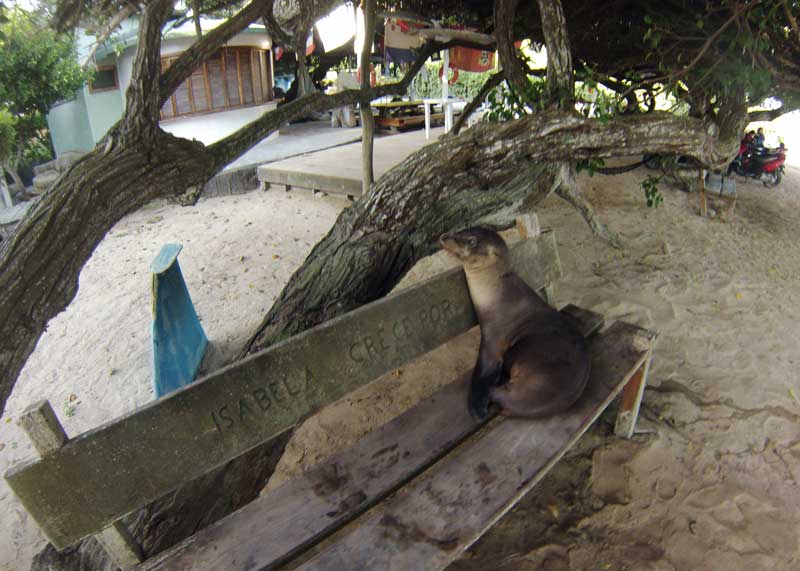
2. What do Galapagos sea lions look like?
With a whiskered nose and ears that stick out, the Galapagos sea lion is one of the most adorable creatures out there. They have foreflippers and back flippers. While they look clumsy on land, they are fast in the water.
They are born chestnut brown, but as they get older their fur changes, with colors ranging from tan to darker brown, to gray. Females are lighter in color than males. Adult males also have a bump on their heads, which the females do not have.
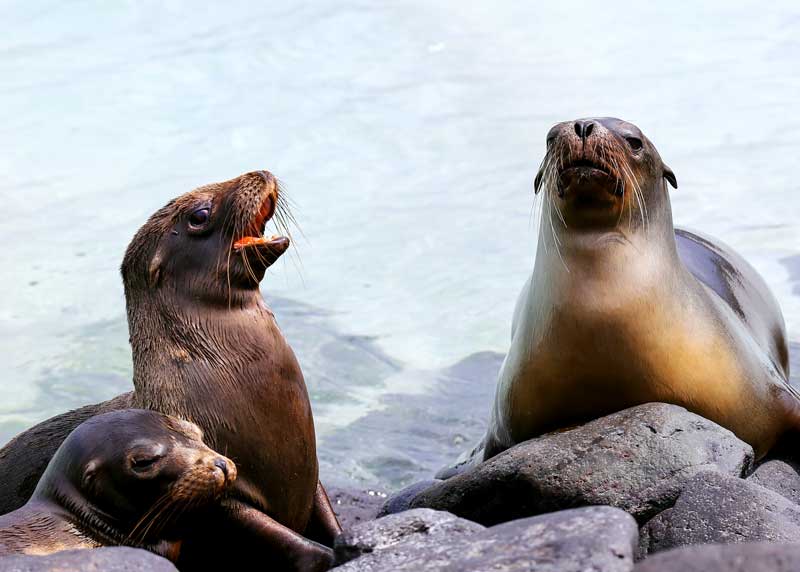
3. How much does a Galapagos sea lion weigh? How big is it?
A Galapagos sea lion can weigh anywhere between 110 to 550 pounds (50 to 250 kilograms).
They vary in length from around 5-8 feet in length (1.5-2.5 meters). The males can weigh up to four times more than the females.
4. What is the smallest sea lion species?
The Galapagos sea lion is the smallest species of sea lion.
5. Is the Galapagos sea lion a type of seal?
No, while they are both Pinnipeds (fin-footed), they are from different animal families.
6. What is the difference between a Galapagos sea lion and a Galapagos fur seal?
There are several differences. For one, the Galapagos fur seal is quite a bit smaller than its sea lion relative.
Also, if you were to take a closer look at their front flippers, you would see that seals have furry flippers with long claws, whereas the sea lion’s flippers are mostly skin-covered with short claws.
And with regards to their back flippers- the sea lion can rotate them inward and uses them to help it walk on land. A seal cannot rotate its back flipper, and gets around by scooting on its belly.
7. What do Galapagos sea lions eat?
Their favorite food is sardines. But if sardines are in short supply, they will dive deeper to catch lantern fish.
8. How deep can a Galapagos sea lion dive?
They can dive up to depths of 1968.5 feet (600 meters). Pretty impressive!
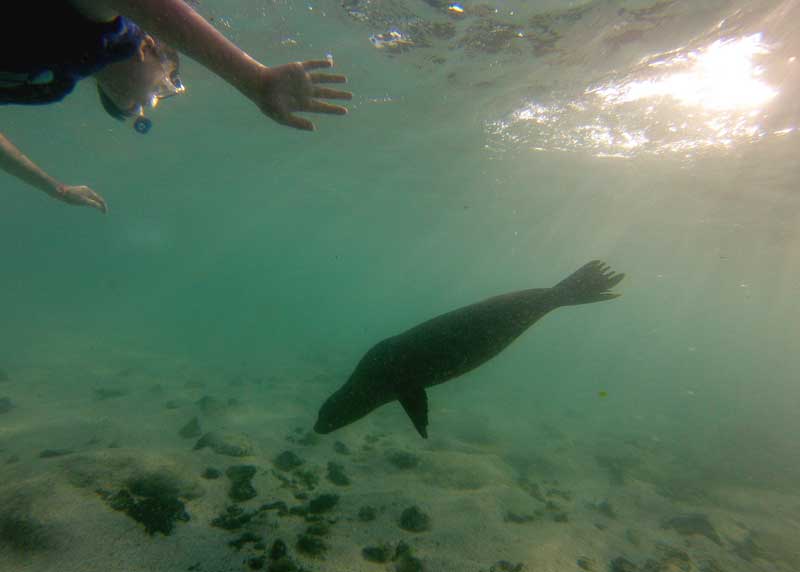
9. How long can a Galapagos sea lion stay underwater?
They can stay underwater for over ten minutes.
10. Where do Galapagos sea lions live?
As indicated by their name, the Galapagos sea lion lives in the Galapagos Islands off of the coast of Ecuador. There are 21 islands that make up the Galapagos Archipelago. The Galapagos sea lion can be found on all those islands.
There is also a colony of Galapagos sea lions on de la Plata Island, just offshore of mainland Ecuador. This colony was introduced to the island in 1986.
There have also been apparent sightings on Isla Gorgona to the north in Colombia, and on Isla del Coco (310 miles/500 kilometers southwest of Costa Rica).
The more remote the island, the less afraid they are of humans. Read about visiting Floreana Island in the Galapagos.
11. Are Galapagos sea lions migratory?
No, the Galapagos sea lion does not migrate, it is quite happy where it is.
12. When is the best time to see a Galapagos sea lion?
As they do not migrate, you can see Galapagos sea lions all year round.
13. What is the habitat of the Galapagos sea lion like?
Galapagos sea lions tend to stick close to the coast. You may find them fishing and playing in the water, or sunning themselves on the rocks and beaches. If it’s a hot and sunny day, they may look for shade under vegetation or under a cliff.
The area that a colony tends to gather on land is called a “hauling-out” area.
14. Are Galapagos sea lions dangerous? Or are they friendly?
Dominant males may show aggression against other male sea lions- if they feel the need to defend their territory and harem of females. And if you happen to be a sardine, watch out!
But the Galapagos sea lion does not feel threatened by humans, and therefore, is not aggressive toward them. In fact, they are known for being curious and playful, especially the young (which do not reach maturity until they are 4 or 5 years old).
If you ever find yourself in the Galapagos Archipelago, you may even have the privilege of swimming with the sea lions. Just remember to be respectful of their space.
And watch out where you leave your backpack, or you may find a Galapagos sea lion using it as a comfy pillow.
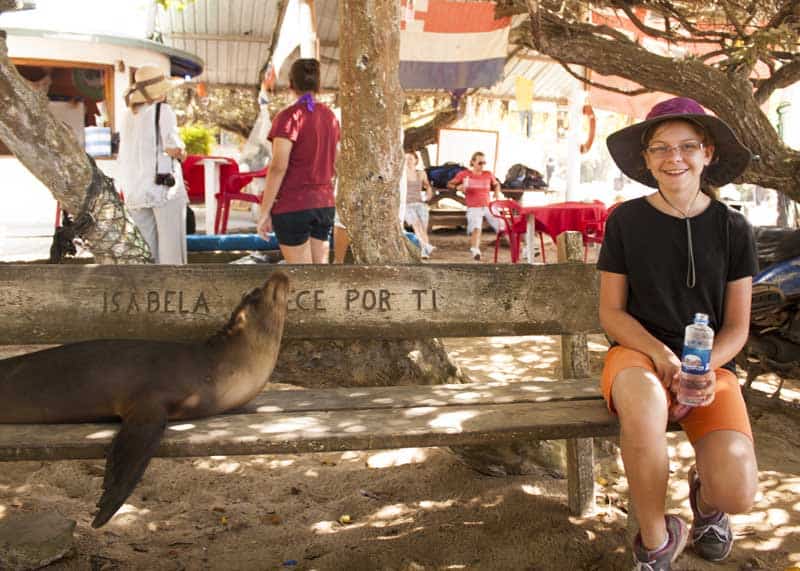
15. What is a male Galapagos sea lion called? What is the female called?
The male is called a bull, and the adult female is called a cow.
16. When is the breeding season of the Galapagos sea lion?
The mating season is usually between July and December, but this can vary slightly from island to island.
Interestingly, the females will mate within three to four weeks after giving birth, however, implantation of the fertilized egg can be delayed for up to two months.
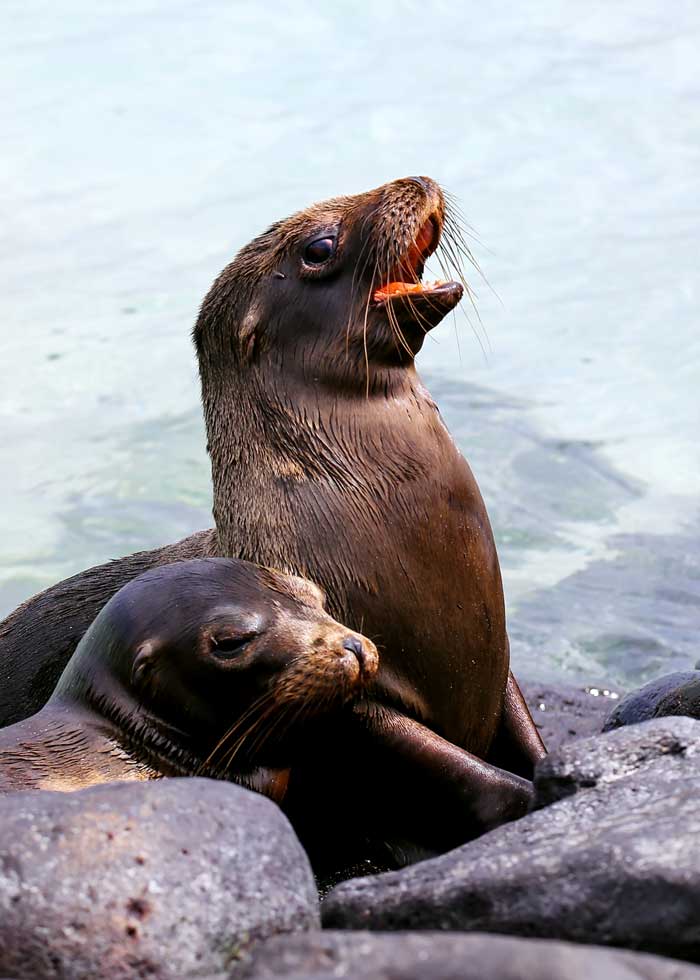
17. What are baby Galapagos sea lions called?
Baby Galapagos sea lions are called pups.
18. Do Galapagos sea lions have any enemies?
Both sharks and killer whales eat Galapagos sea lions as part of their diet. Dogs on the islands may also spread disease to the sea lion population.
However, their biggest threat in recent years is caused by the effects of El Niño, which makes their favorite foods harder to find.
Unfortunately, human waste is also a big problem, with sea lions getting tangled up in garbage, fishing nets, and hooks.
19. Are Galapagos sea lions endangered?
Yes, they are endangered. The Galapagos sea lion population fluctuates somewhere between 20,000-50,000.
Because they only live in one small part of the world, any one threat can have a big and lasting impact.
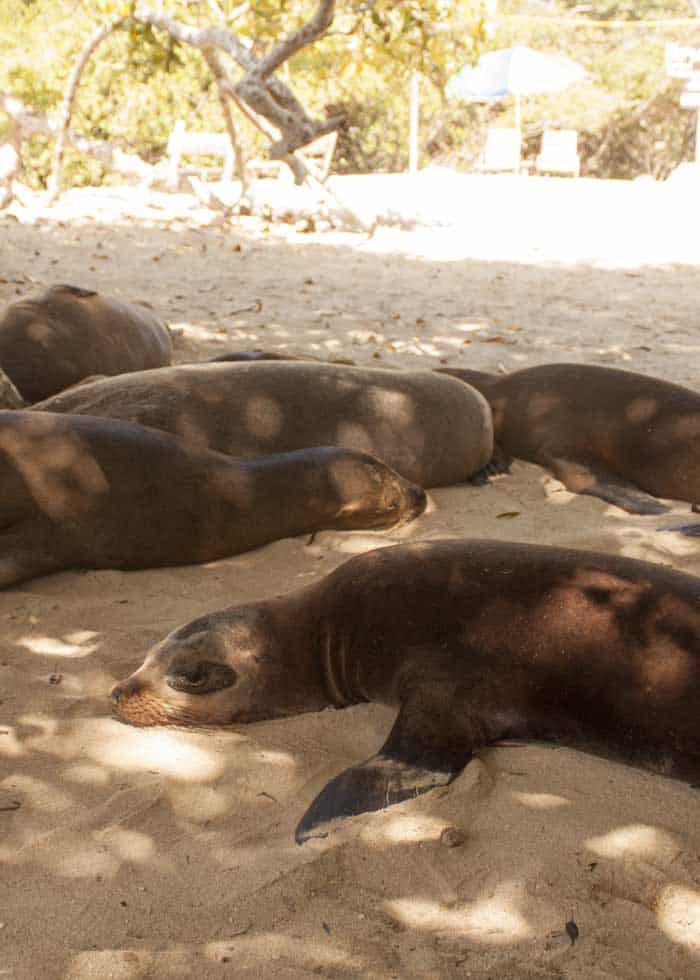
More reading: Conservation vs Preservation
20. How long do Galapagos sea lions live?
They can live from 15 to 24 years. The average is up to 20 years of age.
21. What sounds do Galapagos sea lions make?
The males can be quite vocal, barking in long repetitive sequences. Territorial males bark the loudest.
Young pups growl. A mother sea lion can distinguish the distinctive growl of her pup out of a crowd of 30 or more. The pup will also learn the sound of its mother.
22. Why are Galapagos sea lions important?
Galapagos sea lions play an important role in the ecosystem and food chain of the Galapagos Islands. When their numbers start to drop, it is a sign of much larger problems.
Learn more with these 25 Galapagos Islands Facts.
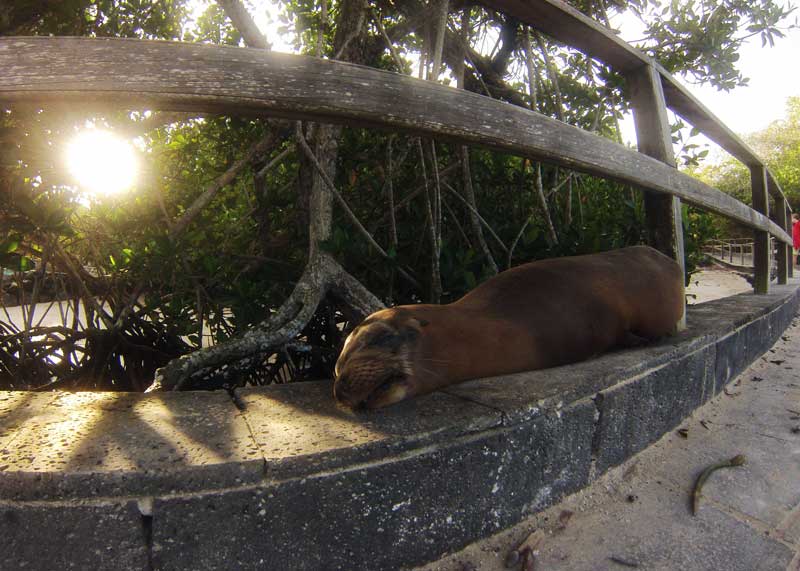
Learn about more of the amazing Galapagos Islands animals.
Your Turn
Have you had the awesome experience of seeing a Galapagos sea lion in real life? What was your experience? Please share your thoughts in the comments below.

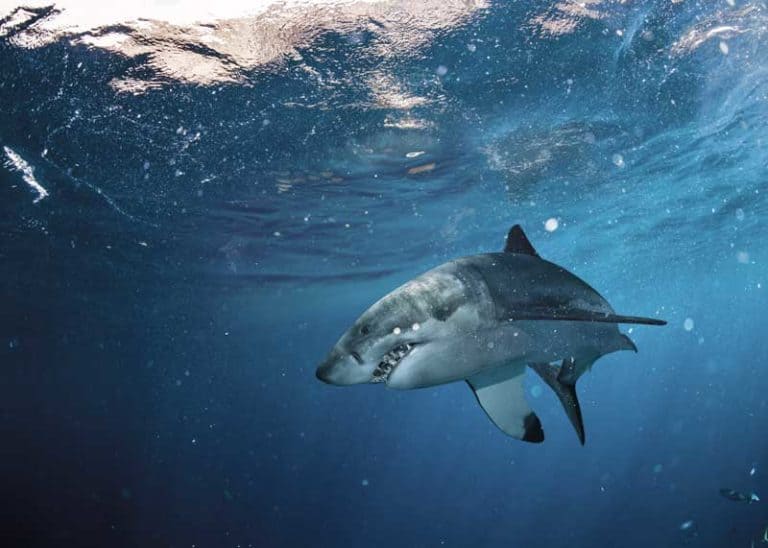



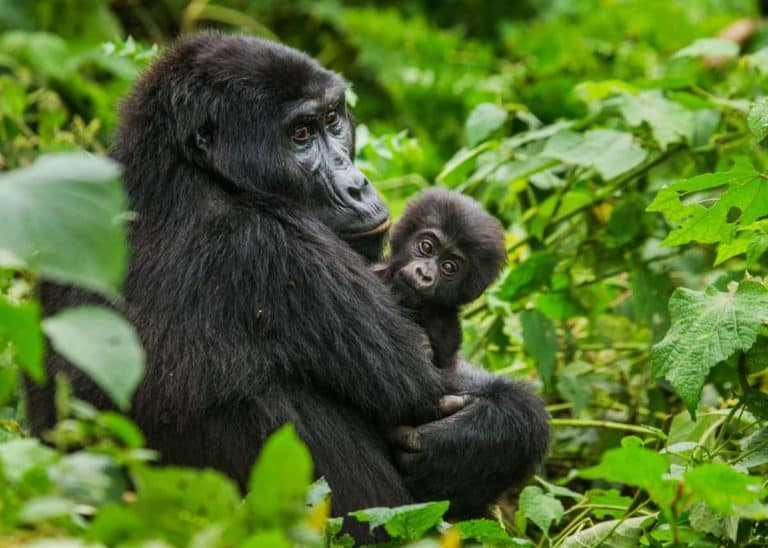

what colers can seals be?